
Not every town in Ohio rolls out the welcome mat for retirees. Based on the latest Overall Retirement Score (ORS), these 19 towns fall short when it comes to what older adults actually want—think walkability, quiet streets, access to health care, and a little peace of mind. Some have safety concerns, others are too noisy or isolating, and a few just lack the basics like decent transit or community events. If you’re looking for comfort, calm, and convenience in your golden years, these are the Ohio towns to skip.
19. Riverside – Poor Public Transit Limits Mobility

Riverside sits just outside Dayton in southwestern Ohio. Although it boasts decent suburban conveniences, the lack of adequate public transportation seriously limits options for retirees who prefer not to drive. Seniors looking for accessible daily activities or independence without a car might find Riverside restrictive, despite its suburban appeal.
Additionally, while Riverside is relatively quiet compared to larger cities, it lacks significant cultural attractions or vibrant community hubs, making retirement life potentially isolating. Families or younger adults seeking affordable suburban living might find Riverside more suited to their lifestyle.
Riverside – ORS 31.51
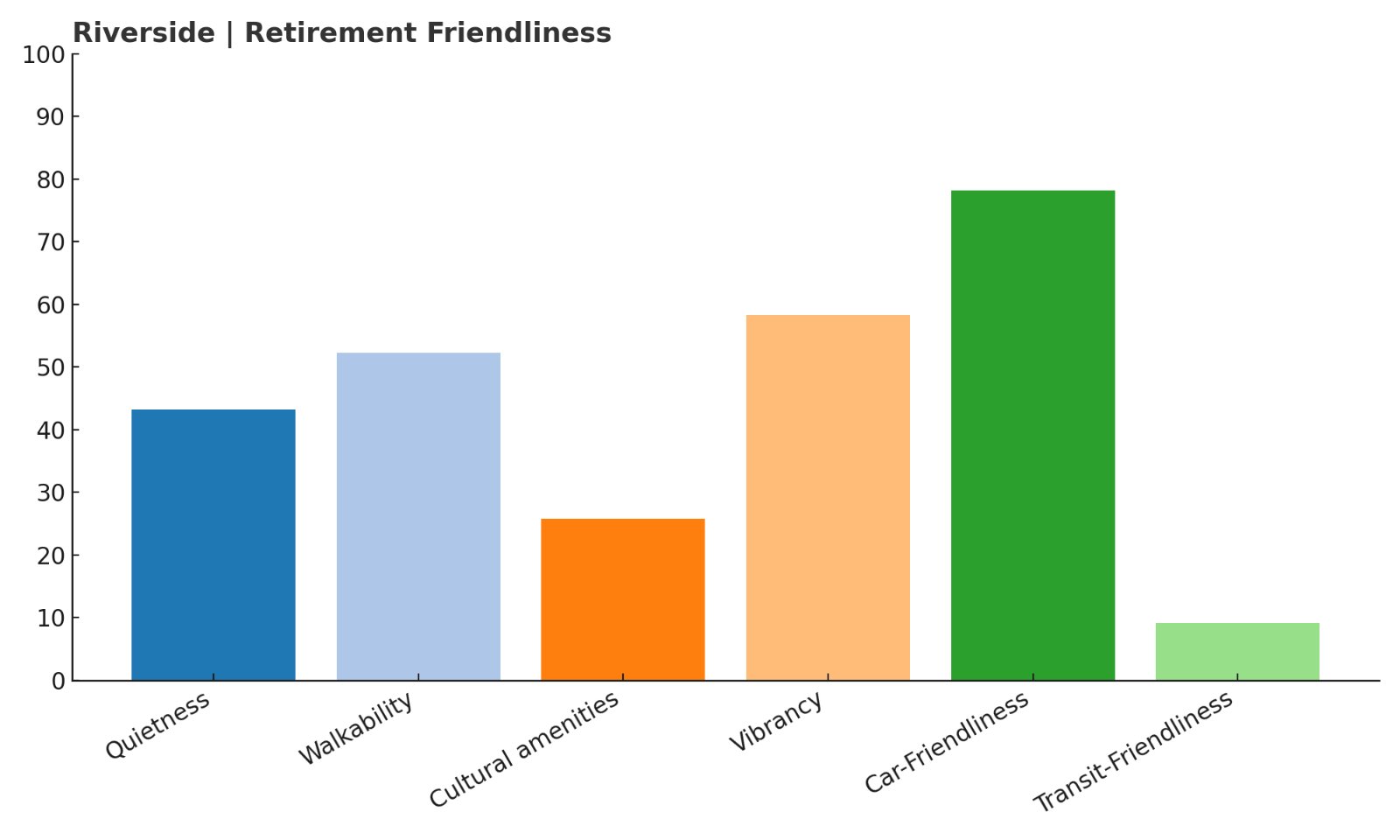
- Overall Retirement Score: 31.51
- Quietness: 43.19
- Walkability: 52.26
- Cultural amenities: 25.72
- Vibrancy: 58.34
- Car-Friendliness: 78.13
- Transit-Friendliness: 9.14
Riverside’s low transit-friendliness score (9.14) highlights the critical challenge retirees face here—limited public transportation options. While the town has moderate walkability and car-friendliness, poor access to cultural amenities further dampens its attractiveness for seniors seeking an engaging retirement community.
18. Fairfax – Too Busy and Loud for a Relaxing Retirement

Fairfax, a small village located near Cincinnati, offers convenience and a high level of activity, but this liveliness makes it challenging for retirees looking for a quieter lifestyle. The busy streets, bustling shopping centers, and heavy commuter traffic contribute significantly to noise and stress, making relaxation difficult for older adults.
Though cultural and dining opportunities are abundant, Fairfax isn’t ideal for seniors needing peace and quiet. Younger professionals and active families would likely thrive here, while retirees searching for serenity would do better elsewhere.
Fairfax – ORS 31.25
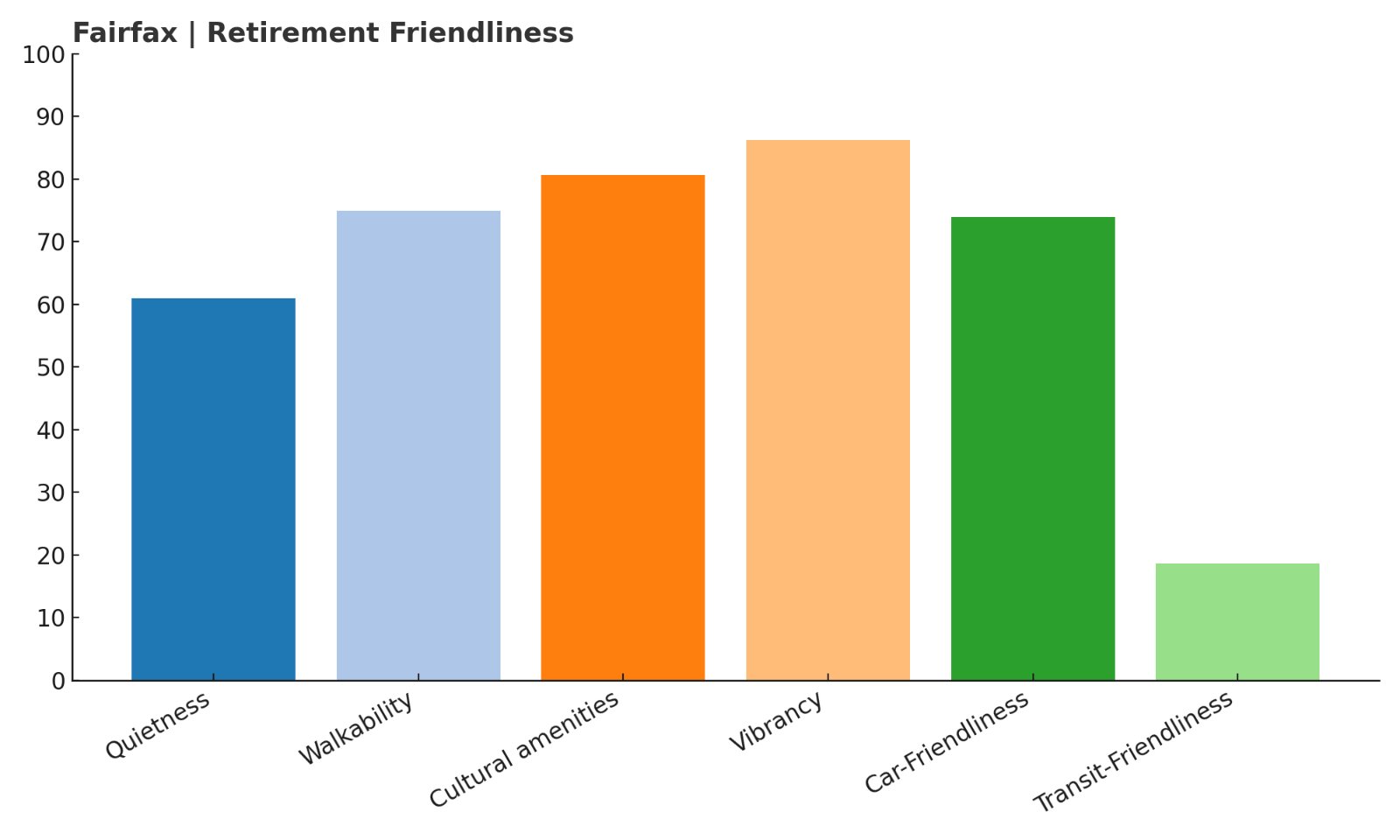
- Overall Retirement Score: 31.25
- Quietness: 60.96
- Walkability: 74.88
- Cultural amenities: 80.6
- Vibrancy: 86.2
- Car-Friendliness: 73.89
- Transit-Friendliness: 18.67
Fairfax scores impressively for walkability (74.88) and cultural amenities (80.6), but its high vibrancy (86.2) and moderate quietness (60.96) indicate a bustling atmosphere that many retirees may find overwhelming. Limited transit options also restrict easy access beyond immediate neighborhood boundaries.
17. Etna – Isolation and Lack of Transportation Options

Etna, a small town east of Columbus, offers a quiet, rural atmosphere that initially seems attractive for retirement. However, its isolation and lack of public transportation present significant issues for seniors who prefer social interaction or require easy access to amenities and healthcare facilities.
With few shops, restaurants, or cultural offerings nearby, retirees might find daily life monotonous and inconvenient. Etna is better suited for families or younger adults looking for a quiet, affordable place to raise children, rather than older adults seeking engagement and convenience.
Etna – ORS 30.38
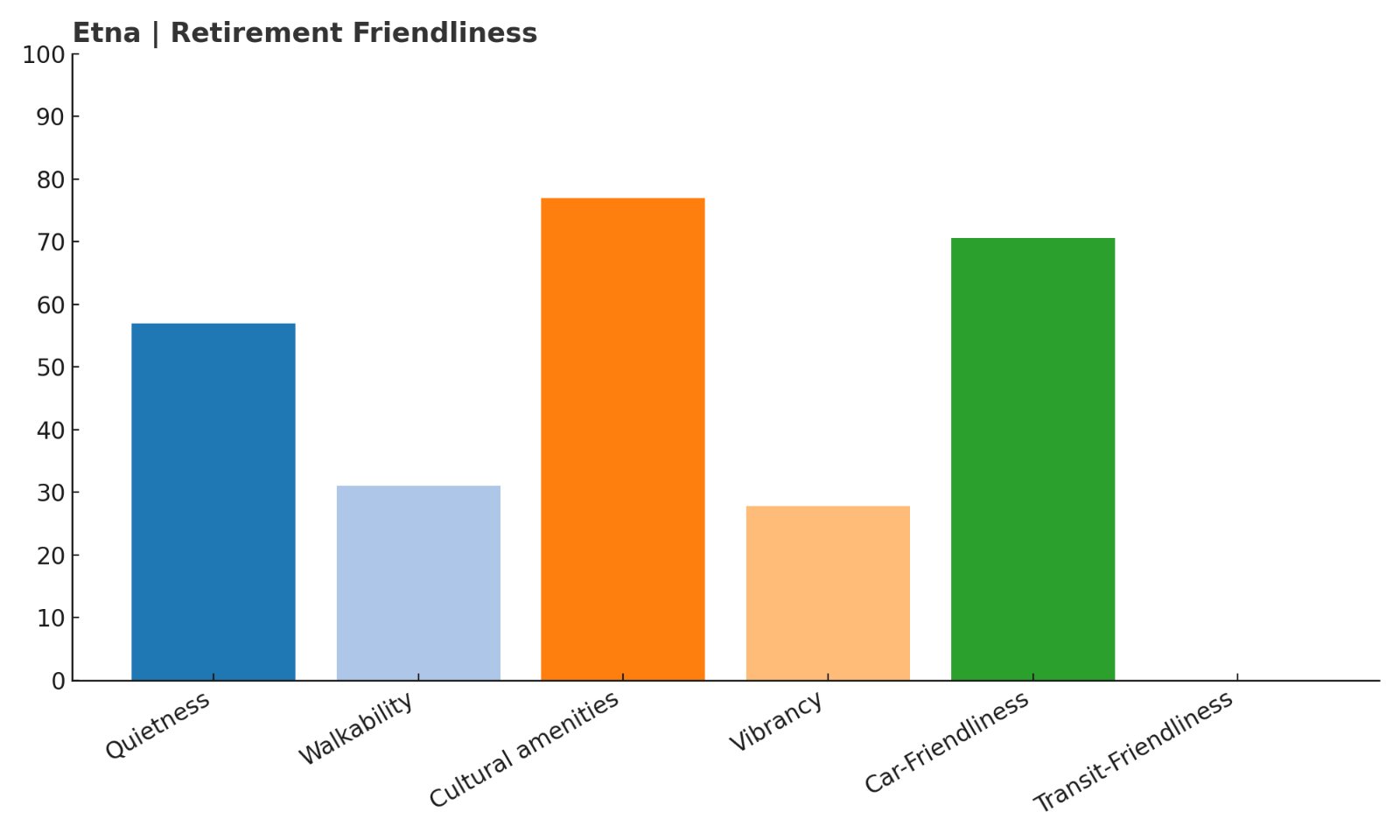
- Overall Retirement Score: 30.38
- Quietness: 56.95
- Walkability: 31.02
- Cultural amenities: 76.94
- Vibrancy: 27.8
- Car-Friendliness: 70.63
- Transit-Friendliness: 0.0
Etna’s lack of transit (0.0 score) and poor walkability (31.02) severely restrict retirees’ independence. While cultural amenities score relatively high due to proximity to Columbus, the low vibrancy means these offerings aren’t easily accessible for seniors who rely heavily on local conveniences.
16. Lockland – Noisy Environment with Limited Cultural Activities

Lockland, situated near Cincinnati, struggles to provide retirees with a peaceful living environment. The town’s industrial history contributes to ongoing noise issues, making quiet, restful living difficult for seniors. Additionally, Lockland offers limited cultural and recreational opportunities, limiting social and intellectual engagement for older adults.
Although Lockland is walkable, the combination of noise, limited cultural amenities, and fewer senior-focused services make it more suitable for younger residents or commuters rather than retirees seeking tranquility and community engagement.
Lockland – ORS 30.16
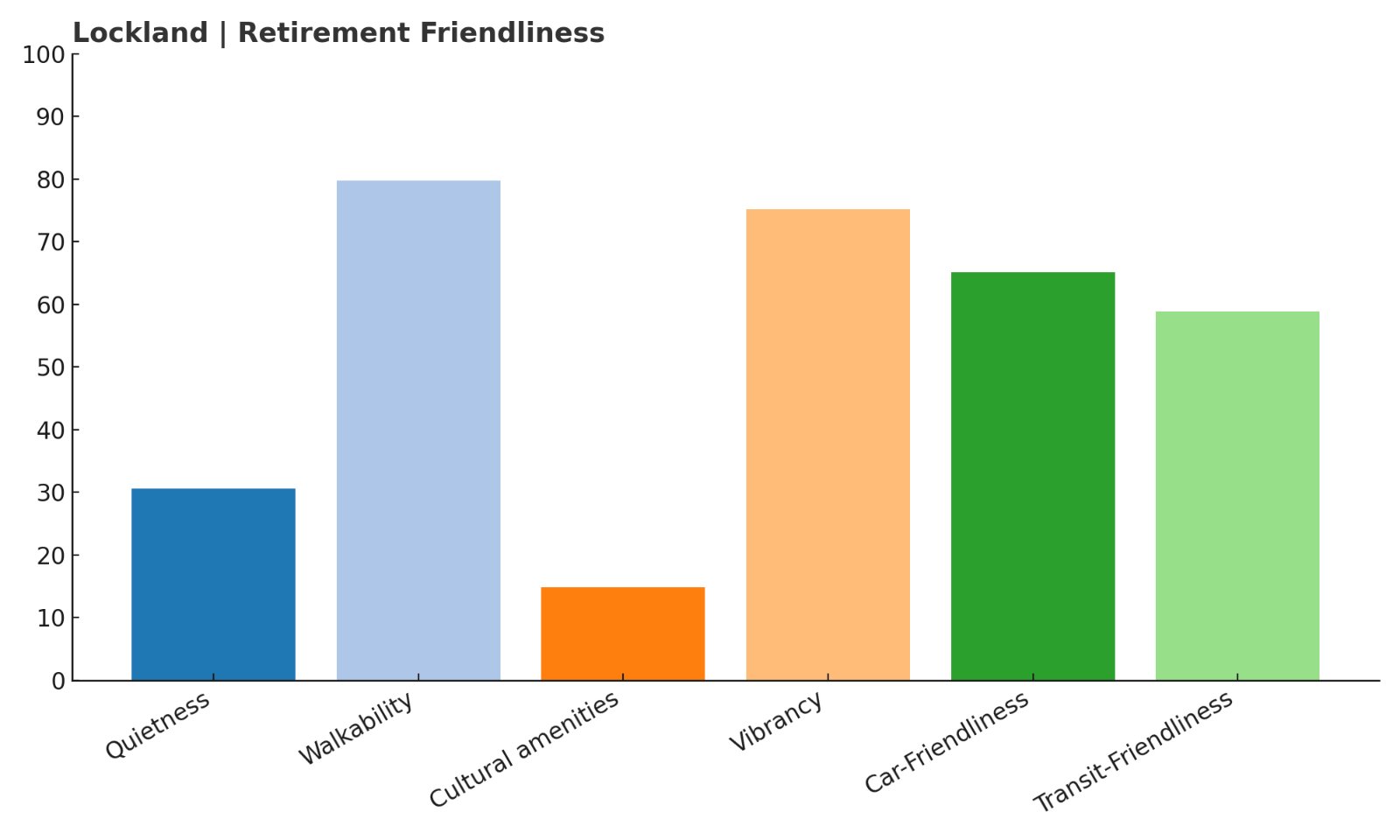
- Overall Retirement Score: 30.16
- Quietness: 30.54
- Walkability: 79.77
- Cultural amenities: 14.82
- Vibrancy: 75.14
- Car-Friendliness: 65.06
- Transit-Friendliness: 58.84
Lockland’s low quietness (30.54) and poor cultural amenities (14.82) significantly detract from its appeal for retirees. Despite decent walkability and transit options, the noisy surroundings and lack of engaging community offerings severely limit its retirement attractiveness.
15. North College Hill – Crowded and Noisy Community

North College Hill, a suburb of Cincinnati, offers high walkability but comes with notable drawbacks for retirees. The town is densely populated and experiences considerable noise from traffic and local businesses, creating an environment that can be stressful and uncomfortable for older residents.
Despite its lively atmosphere, North College Hill has limited cultural amenities and lacks quiet, comfortable spaces suitable for leisurely retirement activities. Young families or working adults might appreciate the proximity to Cincinnati, but retirees would likely find it less than ideal.
North College Hill – ORS 30.01
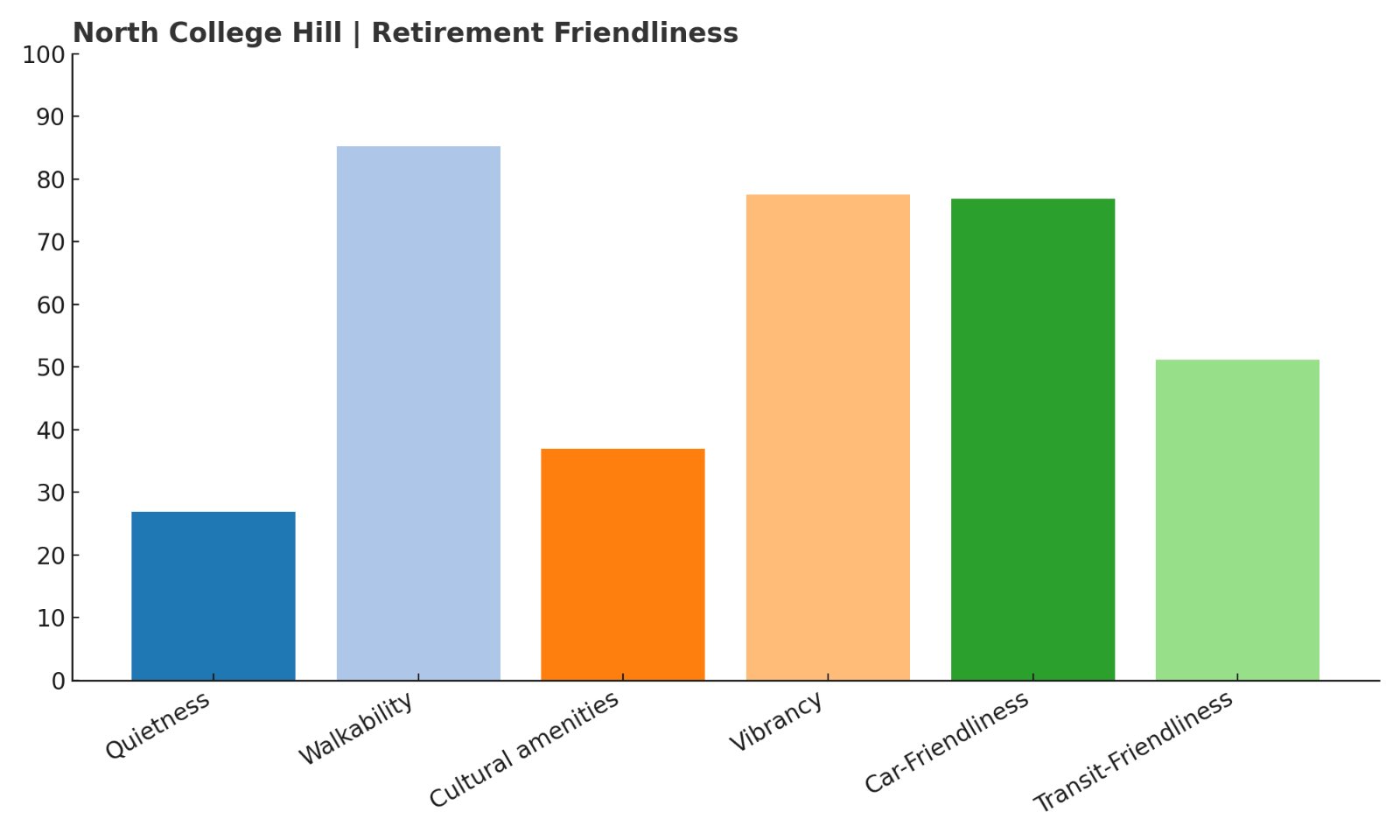
- Overall Retirement Score: 30.01
- Quietness: 26.87
- Walkability: 85.22
- Cultural amenities: 37.0
- Vibrancy: 77.56
- Car-Friendliness: 76.88
- Transit-Friendliness: 51.12
North College Hill’s very low quietness score (26.87) and moderate cultural amenities (37.0) underscore its limitations for senior residents. High vibrancy indicates a busy lifestyle suitable for younger populations, but not ideal for retirees desiring calmness and easy-going daily life.
14. Sardinia – Limited Amenities and Isolation

Sardinia is a small village located in Brown and Highland counties in Ohio. With a population of just over 1,000, it offers a quiet, rural lifestyle. However, the limited amenities and services can pose challenges for retirees seeking convenience and accessibility.
While Sardinia has a village park and a county library, the lack of public transportation and low walkability make it difficult for seniors to access essential services and social activities. The village’s isolation may appeal to those seeking solitude, but it may not be ideal for retirees desiring a more connected community.
Sardinia – ORS 29.91
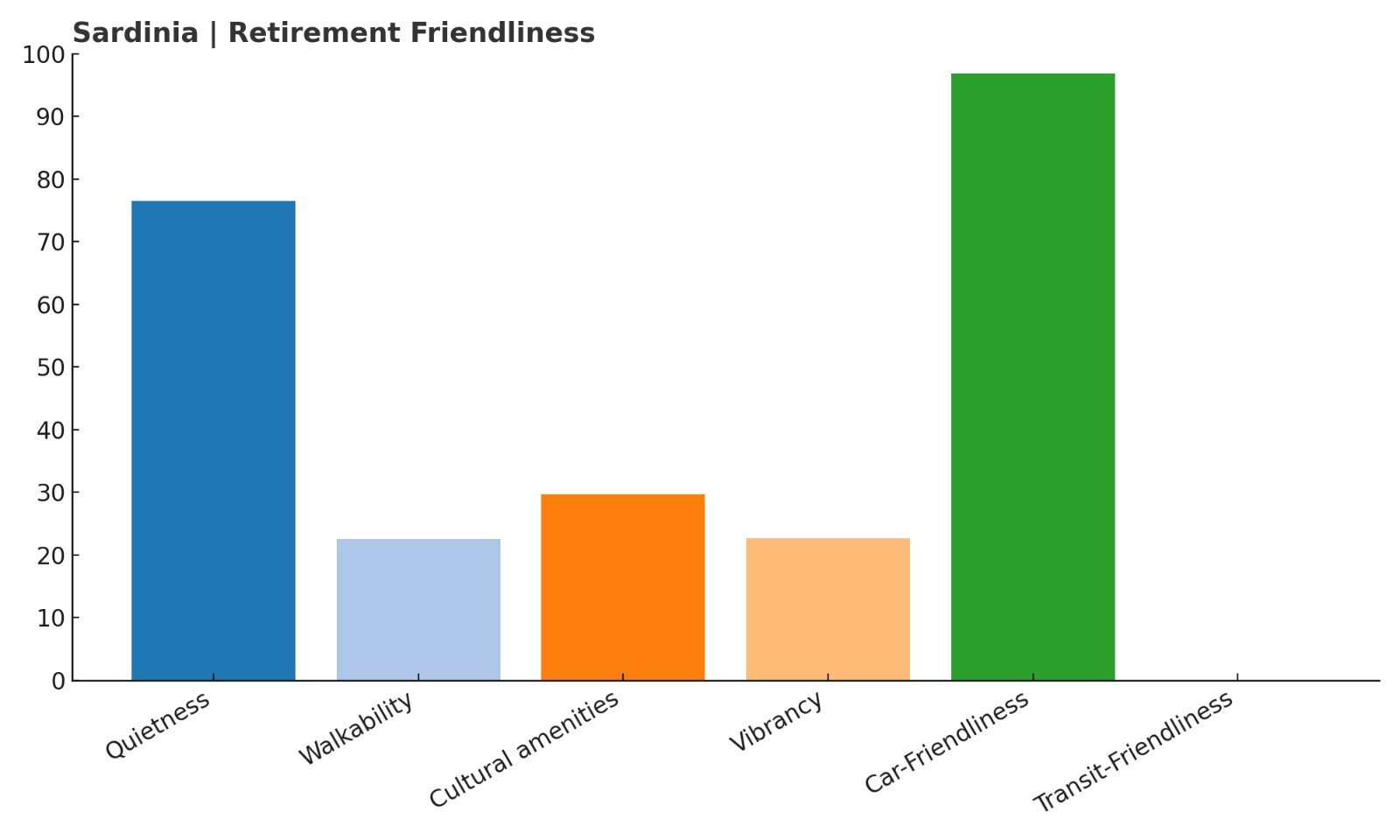
- Overall Retirement Score: 29.91
- Quietness: 76.55
- Walkability: 22.5
- Cultural amenities: 29.64
- Vibrancy: 22.67
- Car-Friendliness: 96.83
- Transit-Friendliness: 0.0
Sardinia’s high car-friendliness score indicates that a personal vehicle is essential for getting around, which may not be suitable for all retirees. The low walkability and transit-friendliness scores highlight the challenges in accessing services without a car.
13. West Farmington – Rural Setting with Limited Services

West Farmington is a village in Trumbull County, Ohio, known for its peaceful, rural setting. With a population of around 500, it offers a close-knit community atmosphere. However, the limited services and amenities may not meet the needs of retirees seeking more convenience.
The village’s lack of public transportation and low walkability can make it challenging for seniors to access healthcare, shopping, and social activities. While the rural charm may appeal to some, the isolation and limited services may not be ideal for all retirees.
West Farmington – ORS 28.31
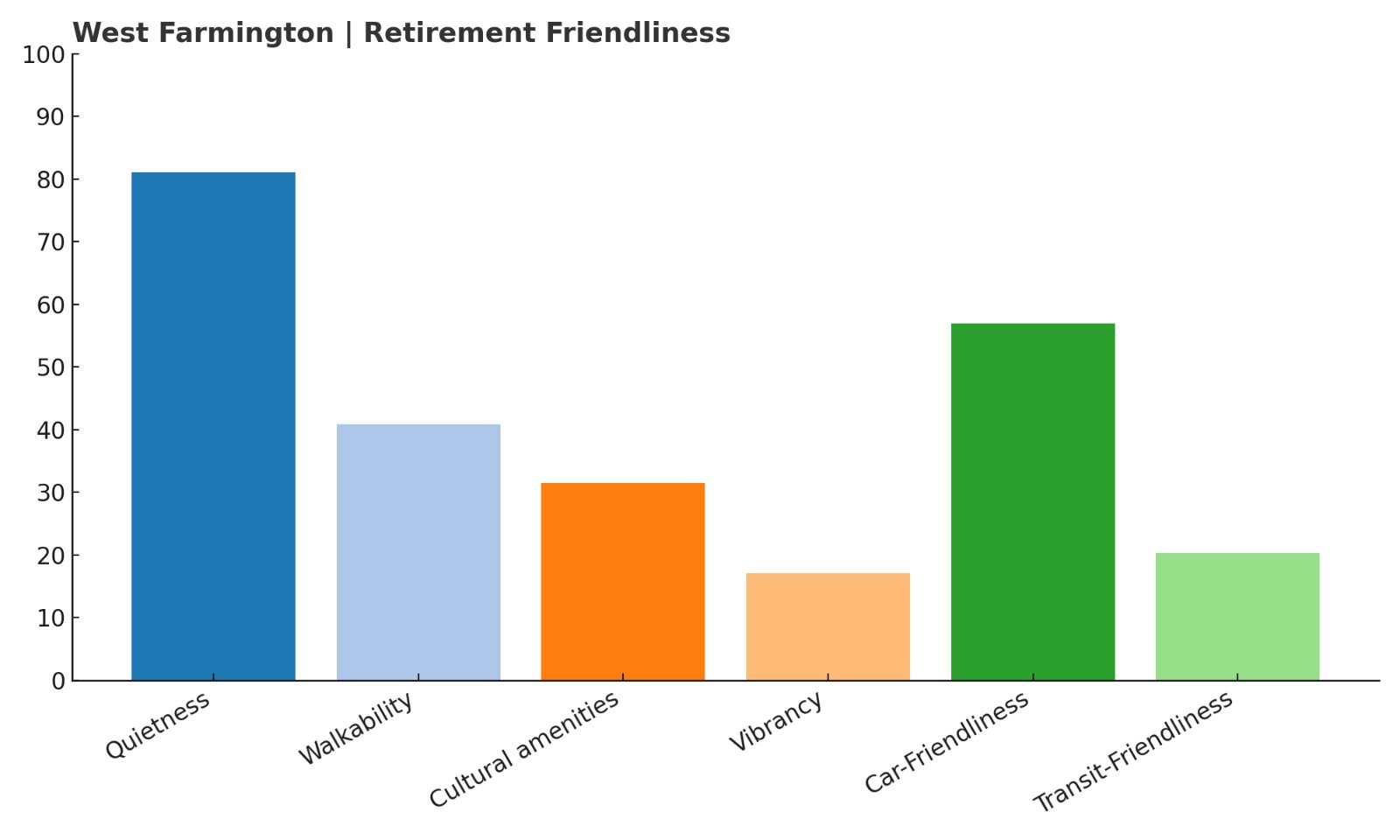
- Overall Retirement Score: 28.31
- Quietness: 81.08
- Walkability: 40.87
- Cultural amenities: 31.51
- Vibrancy: 17.04
- Car-Friendliness: 56.96
- Transit-Friendliness: 20.27
West Farmington’s low scores in walkability and transit-friendliness suggest that retirees without personal transportation may find it difficult to access necessary services and activities.
12. Clarksburg – Small Size Limits Opportunities

Clarksburg is a village in Ross County, Ohio, with a population of approximately 400. Its small size contributes to a tight-knit community, but also limits the availability of services and amenities that retirees may seek.
The village’s limited healthcare facilities, shopping options, and recreational activities may not meet the diverse needs of retirees. Additionally, the absence of public transportation can pose challenges for those who do not drive.
Clarksburg – ORS 28.0
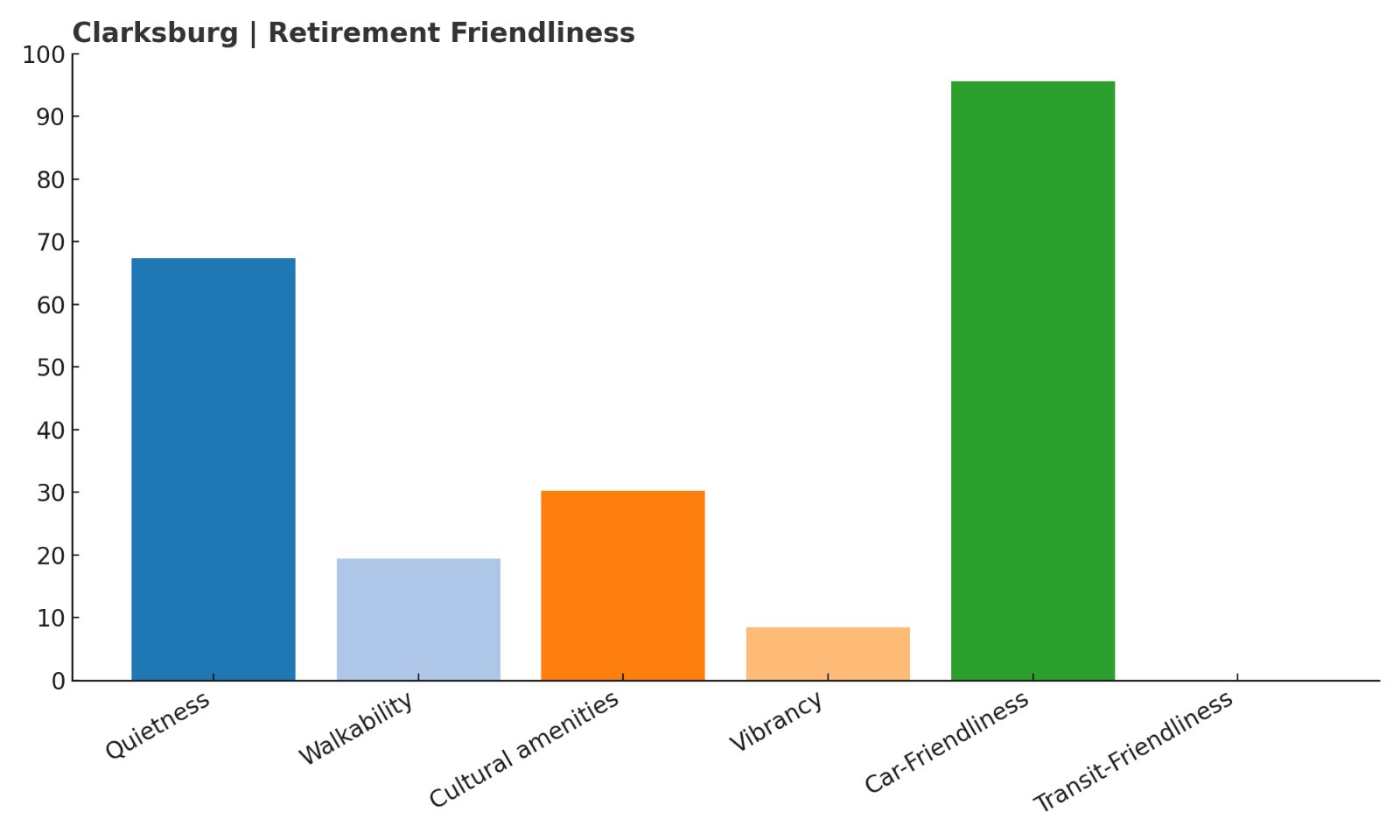
- Overall Retirement Score: 28.0
- Quietness: 67.34
- Walkability: 19.44
- Cultural amenities: 30.28
- Vibrancy: 8.43
- Car-Friendliness: 95.62
- Transit-Friendliness: 0.0
Clarksburg’s high car-friendliness score indicates reliance on personal vehicles, which may not be suitable for all retirees. The low walkability and transit-friendliness scores highlight the challenges in accessing services without a car.
11. New Boston – Economic Challenges and Limited Services

New Boston is a village in Scioto County, Ohio, situated along the Ohio River. While it has a rich industrial history, the village faces economic challenges that impact the availability and quality of services for retirees.
The limited healthcare facilities, shopping options, and recreational activities may not meet the diverse needs of retirees. Additionally, the absence of public transportation can pose challenges for those who do not drive.
New Boston – ORS 27.56
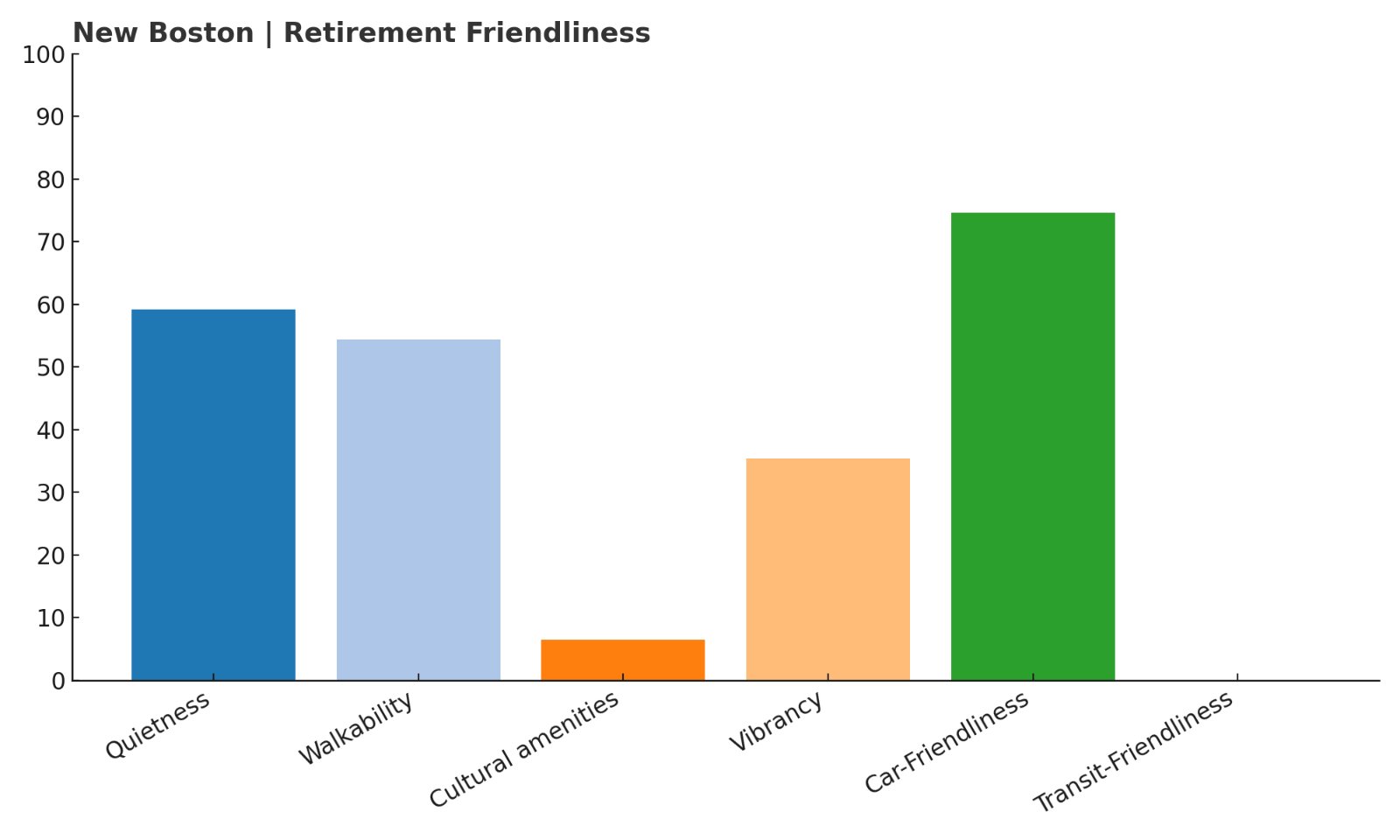
- Overall Retirement Score: 27.56
- Quietness: 59.13
- Walkability: 54.37
- Cultural amenities: 6.46
- Vibrancy: 35.42
- Car-Friendliness: 74.61
- Transit-Friendliness: 0.0
New Boston’s low scores in cultural amenities and transit-friendliness suggest limited opportunities for engagement and mobility for retirees.
10. Elmwood Place – Urban Density with Limited Green Spaces

Elmwood Place is a village in Hamilton County, Ohio, nearly surrounded by the city of Cincinnati. While its urban location offers access to city amenities, the high population density and limited green spaces may not provide the tranquility retirees often seek.
The village’s industrial background and limited recreational areas can impact the quality of life for seniors looking for peaceful environments and outdoor activities.
Elmwood Place – ORS 27.56
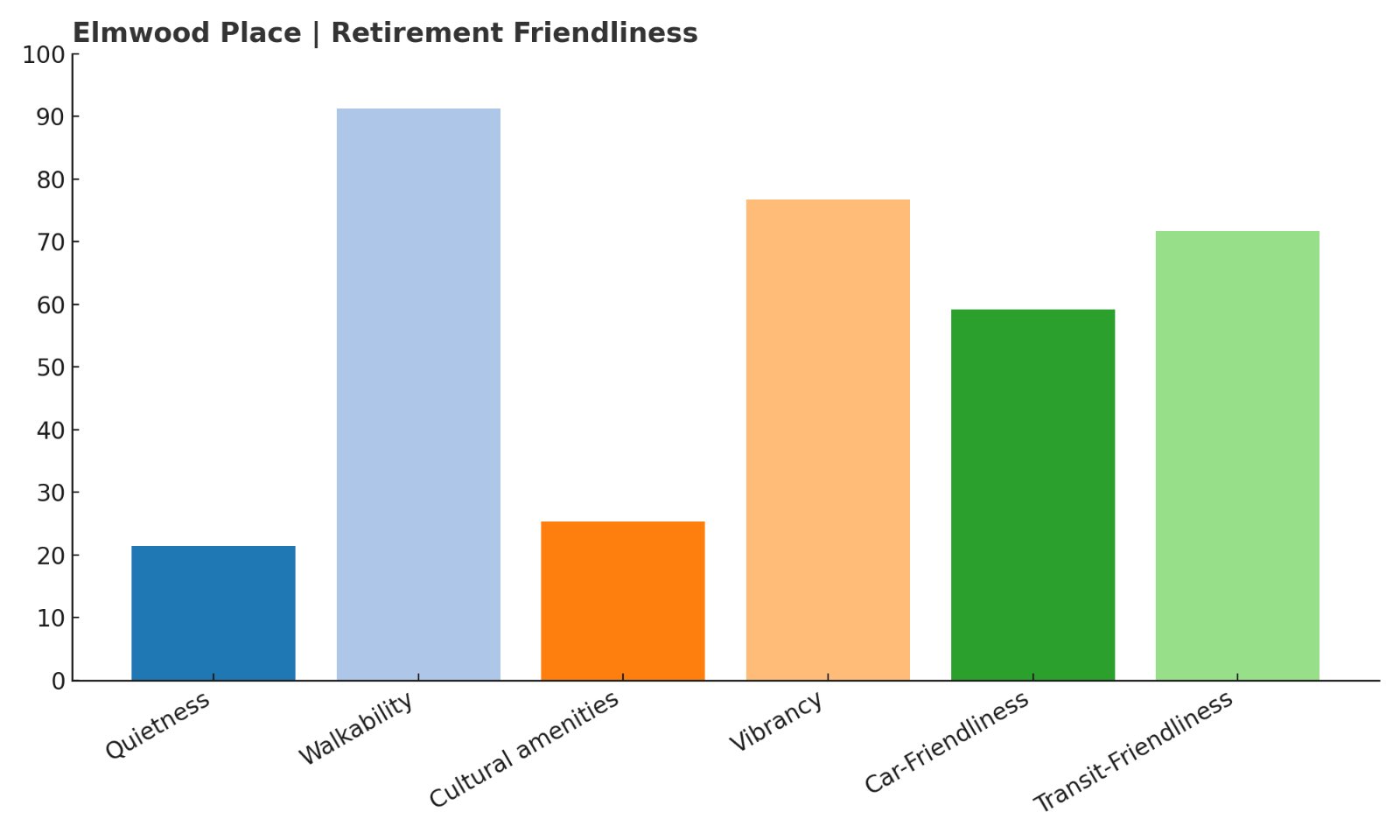
- Overall Retirement Score: 27.56
- Quietness: 21.46
- Walkability: 91.29
- Cultural amenities: 25.29
- Vibrancy: 76.75
- Car-Friendliness: 59.2
- Transit-Friendliness: 71.7
Elmwood Place’s low quietness score indicates a noisy environment, which may not be ideal for retirees seeking a peaceful setting. While walkability and transit options are strong, the lack of green spaces and tranquility may be a drawback.
9. Hooven – Minimal Services and Community Isolation

Hooven, a small community near the Great Miami River, west of Cincinnati, offers rural quietness but lacks many essential amenities retirees typically require. Limited access to healthcare facilities, shopping, and community activities makes everyday living inconvenient for seniors. Hooven’s rural nature also means residents must rely heavily on personal transportation, further isolating those who do not drive.
Though Hooven provides a peaceful setting, it’s better suited to younger families or those who specifically seek solitude and have minimal daily needs. Seniors who prefer active social lives and easy accessibility would likely find Hooven limiting and isolating.
Hooven – ORS 26.17
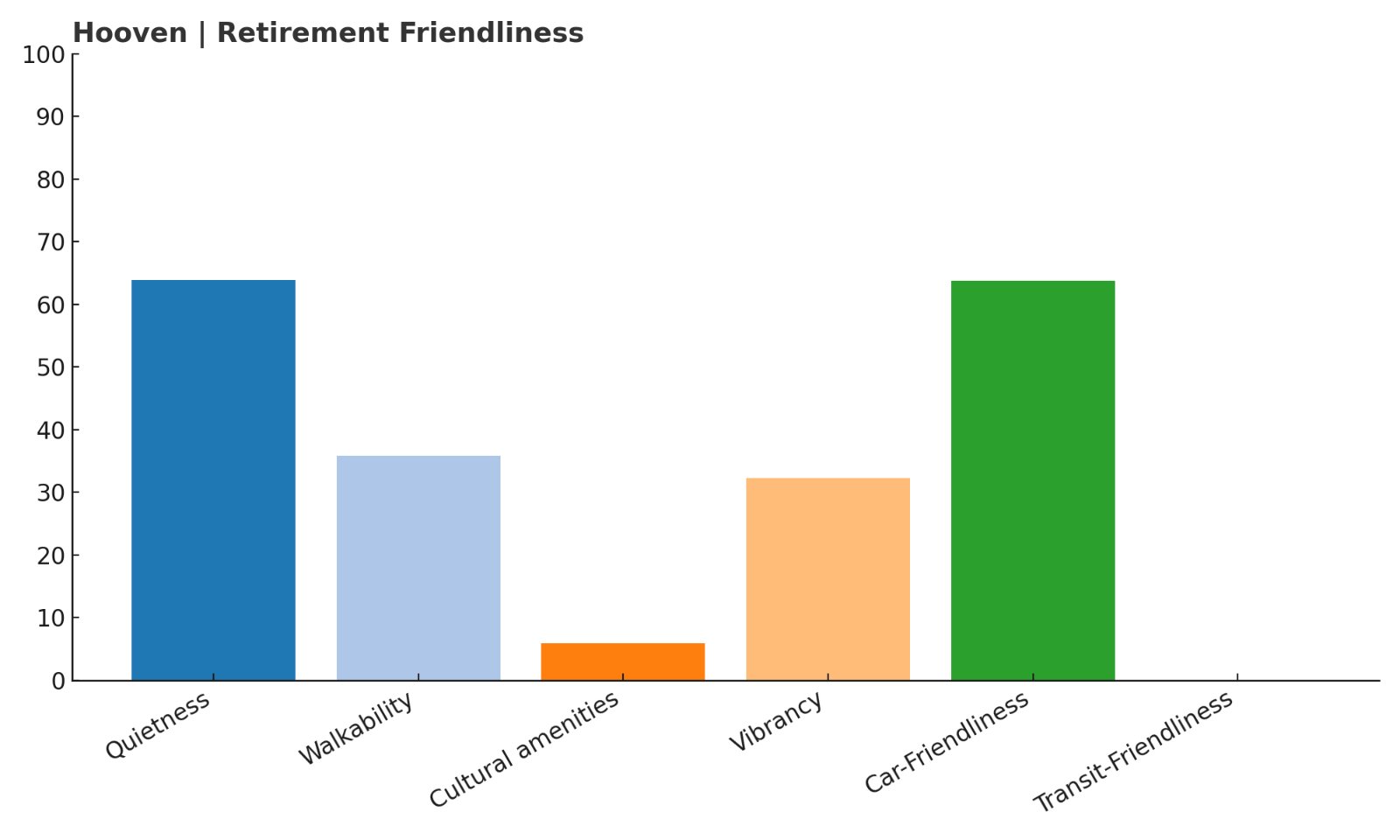
- Overall Retirement Score: 26.17
- Quietness: 63.88
- Walkability: 35.78
- Cultural amenities: 5.87
- Vibrancy: 32.27
- Car-Friendliness: 63.81
- Transit-Friendliness: 0.0
Hooven’s extremely low cultural amenities score (5.87) highlights its lack of community activities, while its zero transit score shows complete dependence on cars, making it unsuitable for retirees seeking convenient mobility and social engagement.
8. Rutland – Extreme Isolation and Limited Social Life

Rutland, located in southeastern Ohio’s Meigs County, epitomizes rural isolation. The village has fewer than 400 residents, limited retail options, and minimal community resources. Such isolation creates significant challenges for retirees, including limited healthcare services and social opportunities, resulting in potential loneliness and lack of essential services.
Although Rutland’s countryside tranquility appeals to certain lifestyles, seniors looking for accessibility, healthcare proximity, or vibrant social communities would find life difficult here. The town primarily suits those explicitly seeking extreme rural living with self-sufficient lifestyles.
Rutland – ORS 25.82
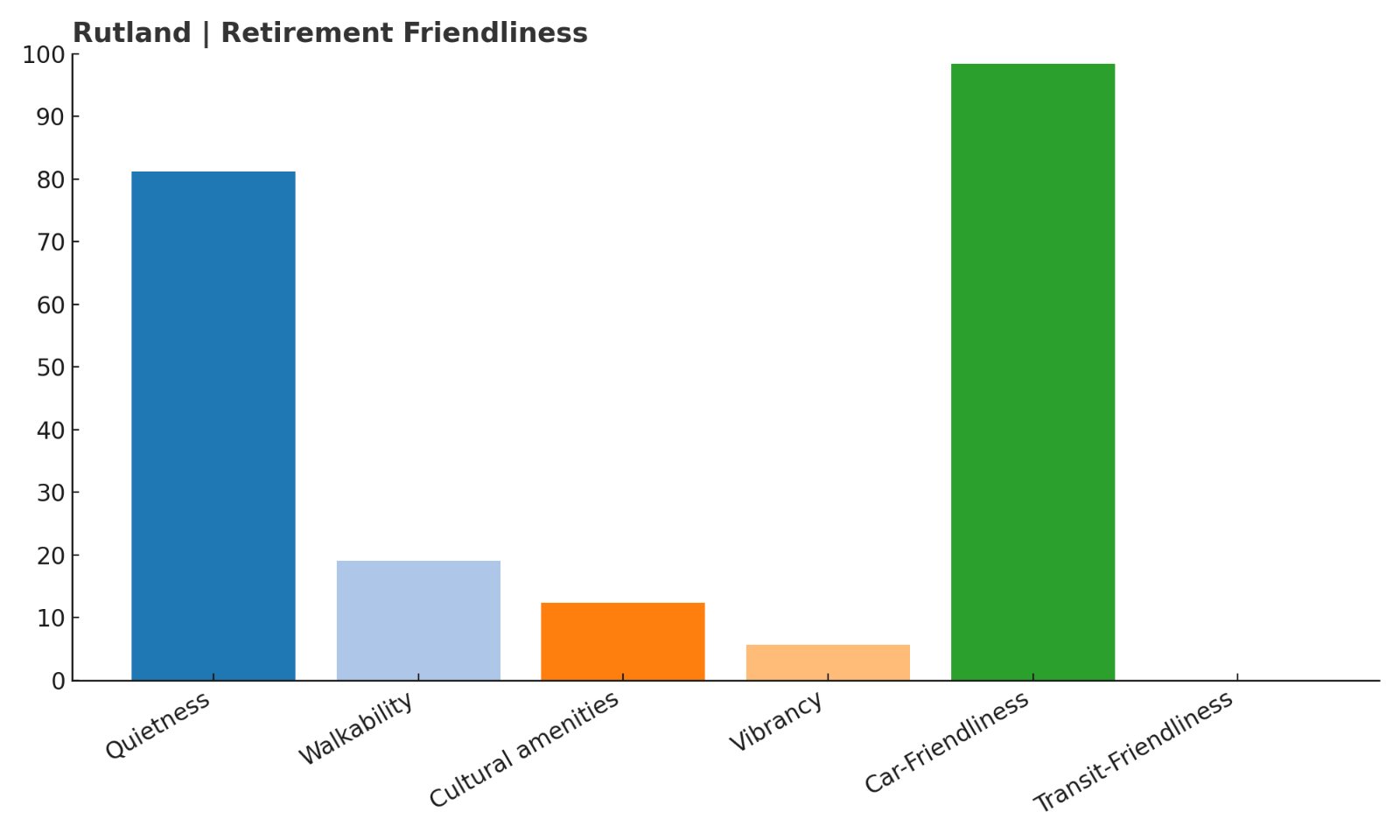
- Overall Retirement Score: 25.82
- Quietness: 81.24
- Walkability: 19.07
- Cultural amenities: 12.39
- Vibrancy: 5.62
- Car-Friendliness: 98.43
- Transit-Friendliness: 0.0
Rutland’s exceptionally low vibrancy (5.62) and minimal walkability reinforce the isolated nature of the town. High car dependency limits independence for retirees who don’t drive, significantly reducing its desirability.
7. East Cleveland – Safety Concerns and Declining Infrastructure

East Cleveland, immediately adjacent to Cleveland’s city limits, struggles with well-documented safety and infrastructure challenges. Persistent economic struggles have led to declining community services, poorly maintained streets, and reduced public safety, creating an uncomfortable environment for retirees.
Though its proximity to Cleveland offers potential access to urban conveniences, East Cleveland itself lacks the stability and comfort retirees often seek. Younger residents or those seeking affordability near Cleveland might overlook these drawbacks, but older adults likely would prefer safer and more supportive communities.
East Cleveland – ORS 25.12
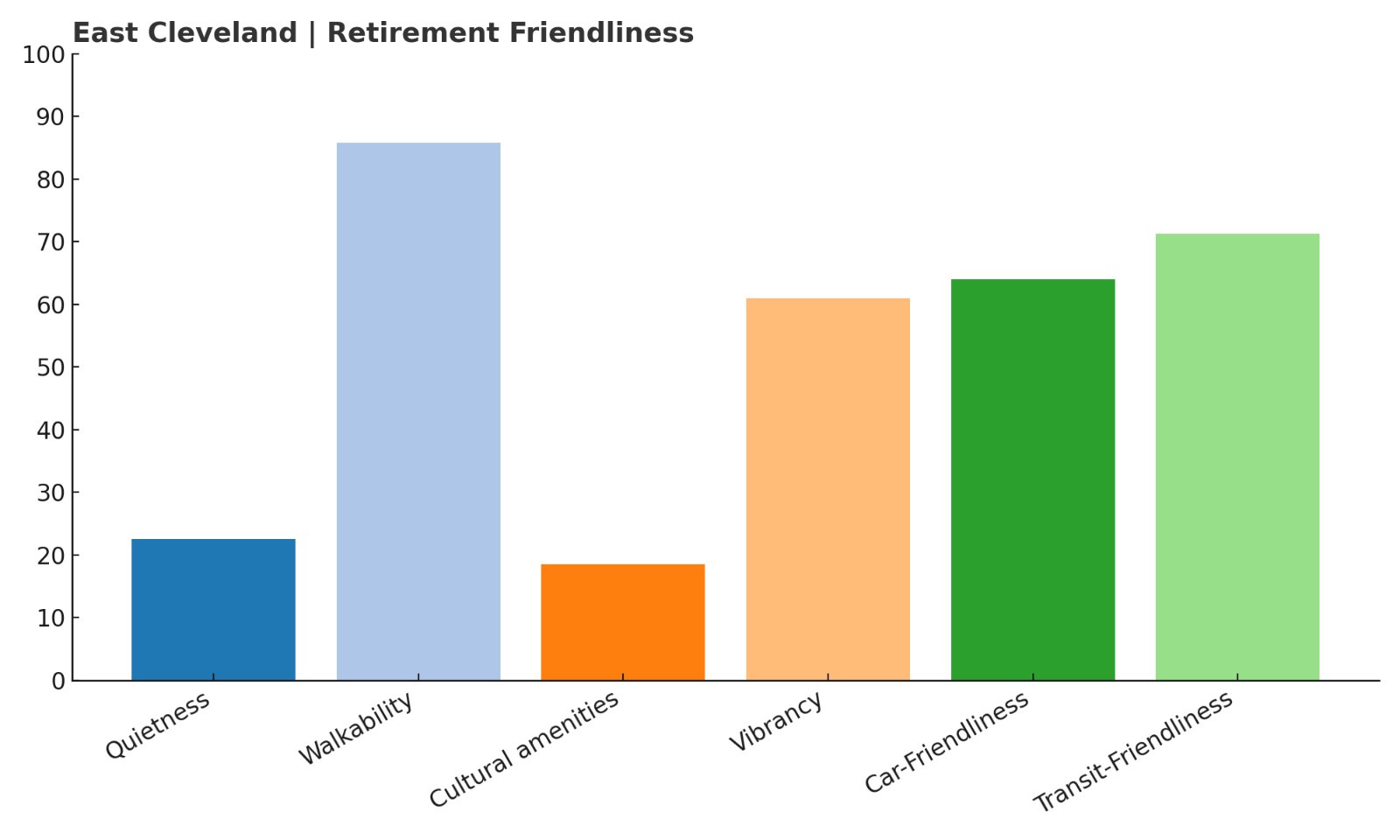
- Overall Retirement Score: 25.12
- Quietness: 22.56
- Walkability: 85.79
- Cultural amenities: 18.46
- Vibrancy: 61.01
- Car-Friendliness: 63.95
- Transit-Friendliness: 71.24
East Cleveland’s low quietness score (22.56) and subpar cultural amenities emphasize the town’s struggle to offer a relaxing, stimulating environment for retirees. Despite strong walkability and decent public transportation, its safety concerns overshadow potential advantages.
6. Moraine – Limited Appeal for Active Seniors

Moraine, a suburb of Dayton, is largely known for its industrial heritage, influencing its limited residential appeal for retirees. The presence of factories and warehouses creates a less visually appealing environment, coupled with moderate noise levels unsuitable for older residents seeking peaceful surroundings.
The town has few engaging cultural or social venues for seniors, making it challenging to build meaningful social connections and stay active. Moraine is better aligned with younger working families or those employed locally in manufacturing, rather than retirees looking for leisurely activities or community interaction.
Moraine – ORS 24.56
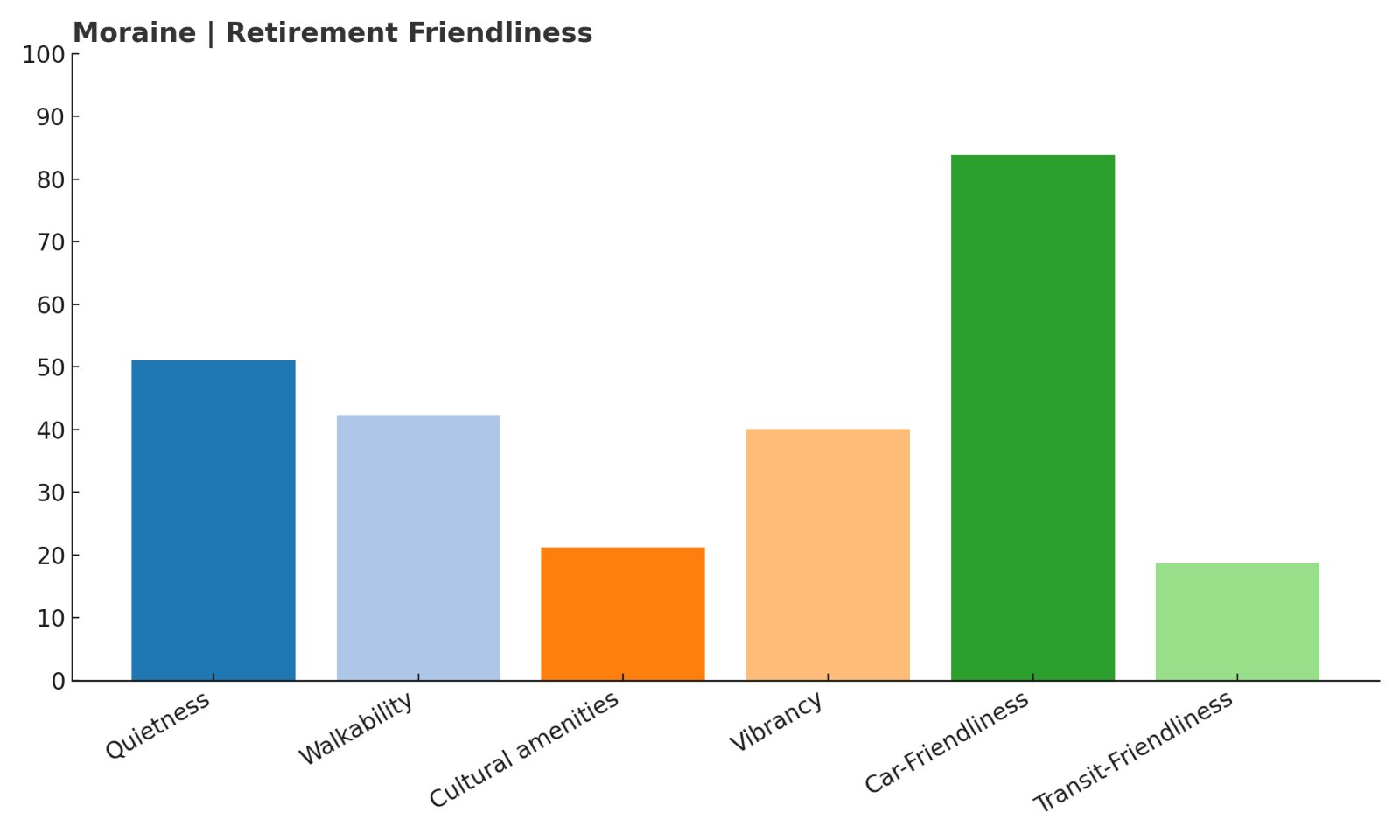
- Overall Retirement Score: 24.56
- Quietness: 51.0
- Walkability: 42.31
- Cultural amenities: 21.14
- Vibrancy: 40.03
- Car-Friendliness: 83.87
- Transit-Friendliness: 18.62
Moraine’s modest quietness score (51.0) and limited cultural amenities illustrate its unsuitability for retirees seeking engaging social and cultural opportunities. Limited transit options further restrict easy mobility and independence for older residents.
5. Cleveland – Urban Challenges Deter Retirees

Cleveland, Ohio’s second-largest city, offers diverse cultural activities but struggles significantly with issues like noise, congestion, and unevenly distributed amenities. While major hospitals and entertainment venues exist, retirees often find navigating the city’s busy environment overwhelming, detracting from daily comfort and convenience.
The high cost of urban living and persistent issues with crime in certain neighborhoods further diminish Cleveland’s appeal to seniors. Active young professionals or those attracted to urban life might enjoy Cleveland’s vibrancy, whereas retirees generally seek quieter, safer, and more relaxed environments elsewhere.
Cleveland – ORS 22.67
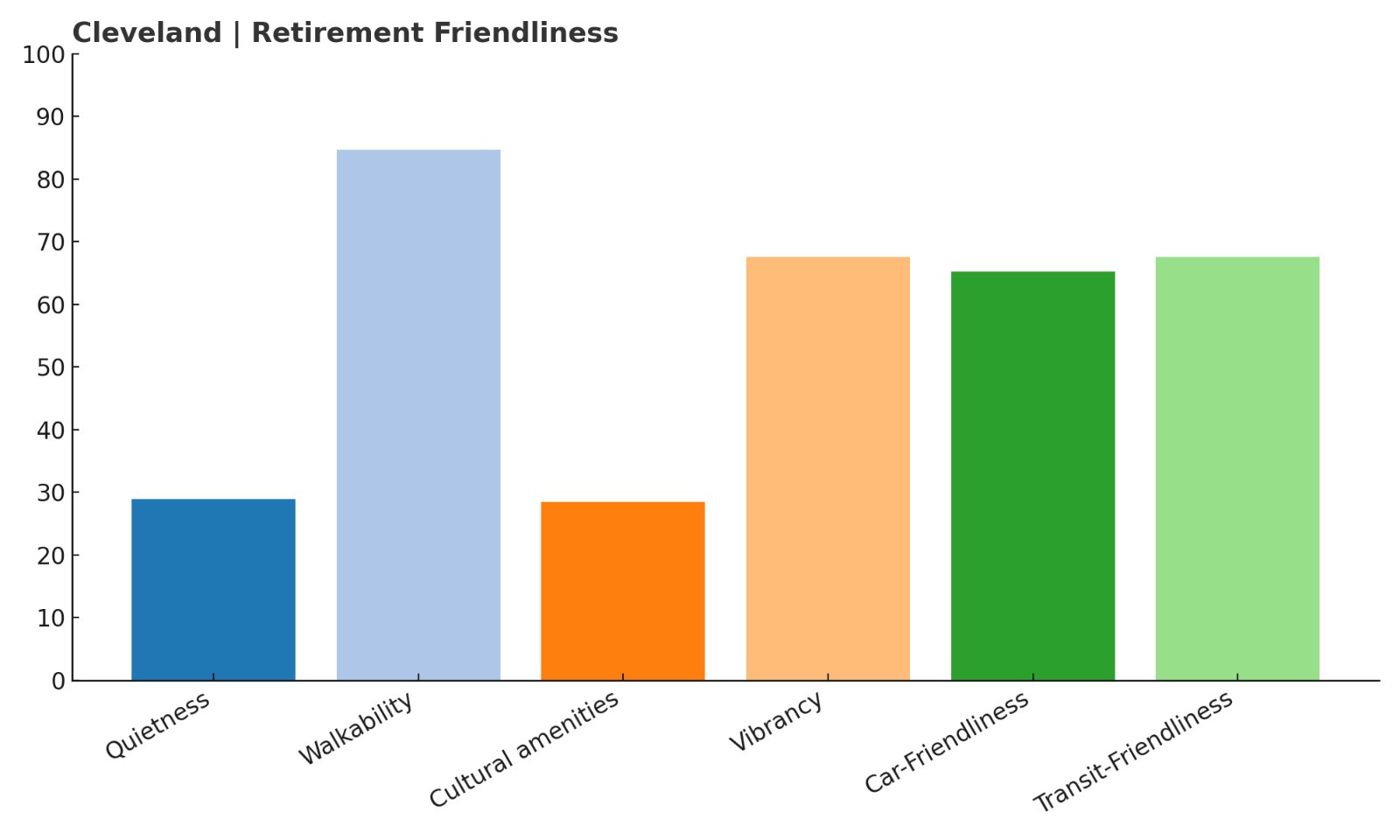
- Overall Retirement Score: 22.67
- Quietness: 28.89
- Walkability: 84.7
- Cultural amenities: 28.49
- Vibrancy: 67.51
- Car-Friendliness: 65.25
- Transit-Friendliness: 67.57
Cleveland’s low quietness score (28.89) highlights the noisy, busy environment unsuitable for relaxed senior living. Despite good walkability and decent transportation, concerns about safety and uneven cultural availability significantly limit its retirement appeal.
4. Cheviot – Noise and Limited Senior Services

Cheviot is a lively suburb located northwest of Cincinnati, known for its bustling streets, local pubs, and community events. While younger adults and families enjoy this energy, retirees often find the continuous noise and busy atmosphere stressful and exhausting. The town’s active nightlife and traffic can interrupt the quiet lifestyle seniors typically prefer.
Additionally, Cheviot lacks sufficient senior-specific amenities like accessible recreational facilities and healthcare options. Although walkability is excellent, retirees may still struggle with the shortage of nearby peaceful retreats and senior-friendly services.
Cheviot – ORS 22.47
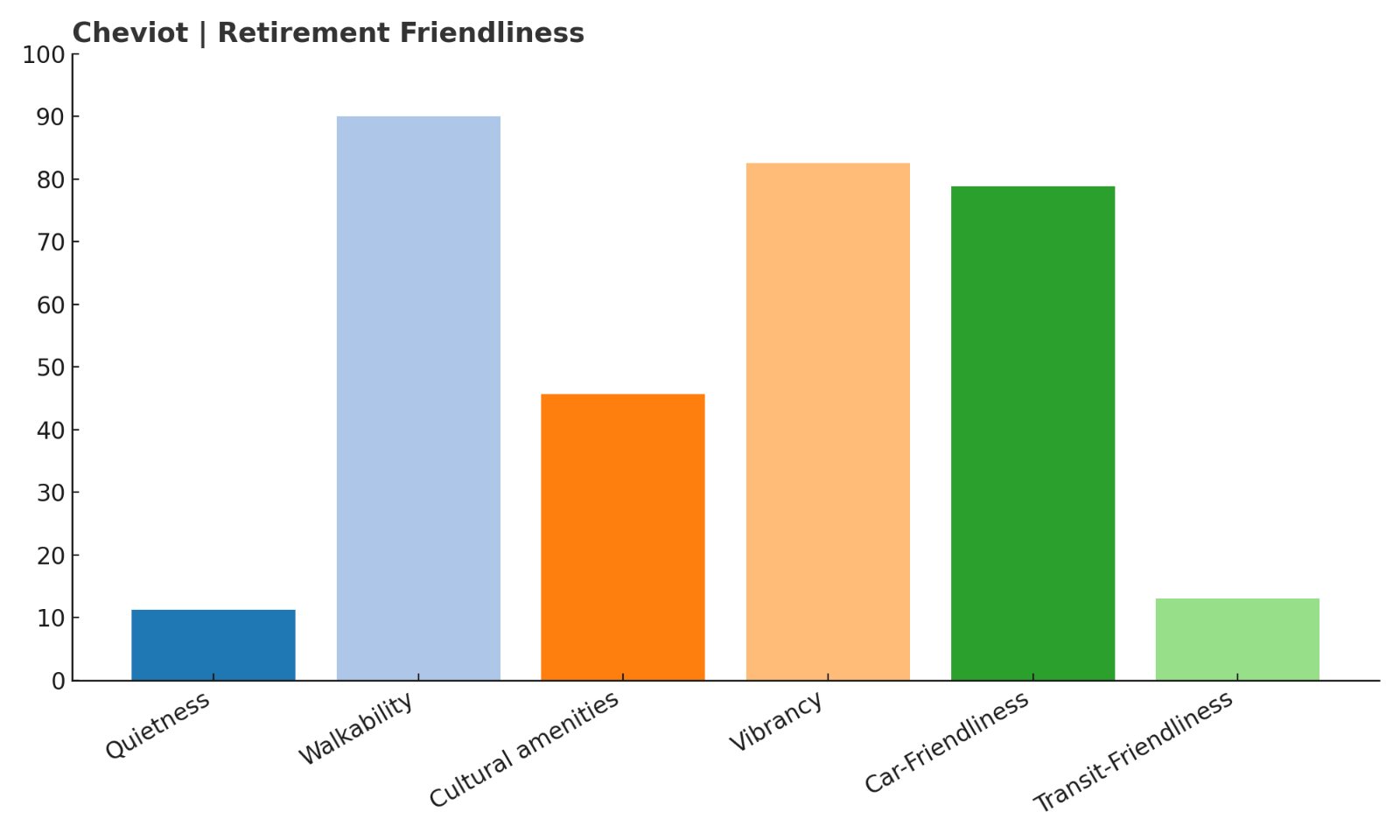
- Overall Retirement Score: 22.47
- Quietness: 11.25
- Walkability: 89.98
- Cultural amenities: 45.68
- Vibrancy: 82.49
- Car-Friendliness: 78.82
- Transit-Friendliness: 12.99
Cheviot’s extremely low quietness score (11.25) underscores its unsuitability for retirees seeking peace. Its low transit-friendliness (12.99) further restricts senior mobility, despite its strong walkability.
3. New Miami – Struggling Infrastructure and Few Senior Amenities

New Miami, located in Butler County near Hamilton, faces multiple challenges that make it difficult for retirees. The town struggles economically, which contributes to deteriorating roads, limited healthcare facilities, and few recreational or cultural activities suitable for older adults. These issues significantly impact the quality of life for retirees seeking comfort and convenience.
While New Miami is affordable, it lacks essential amenities and community support systems that retirees typically prioritize. Families seeking low-cost housing might cope with these issues, but seniors often find the town’s conditions inadequate for a comfortable retirement.
New Miami – ORS 16.79

- Overall Retirement Score: 16.79
- Quietness: 40.36
- Walkability: 67.75
- Cultural amenities: 11.39
- Vibrancy: 36.2
- Car-Friendliness: 87.87
- Transit-Friendliness: 0.0
New Miami’s exceptionally low cultural amenities score (11.39) and nonexistent public transit limit retirees’ quality of life significantly, reinforcing its low desirability despite its affordability and car-friendliness.
2. Whitehall – High Crime Rates and Unfavorable Conditions

Whitehall, a suburban city east of Columbus, faces persistent challenges that significantly impact retirees. High crime rates and busy, congested streets create a stressful and uncomfortable environment, making seniors feel unsafe and unsettled. The town’s predominantly commercial and industrial zones further detract from its appeal.
Despite proximity to Columbus, Whitehall lacks substantial cultural amenities tailored specifically for seniors, and its ongoing public safety concerns overshadow potential benefits of urban access. Younger professionals might find opportunities here, but retirees will likely seek more secure and quieter communities.
Whitehall – ORS 13.18
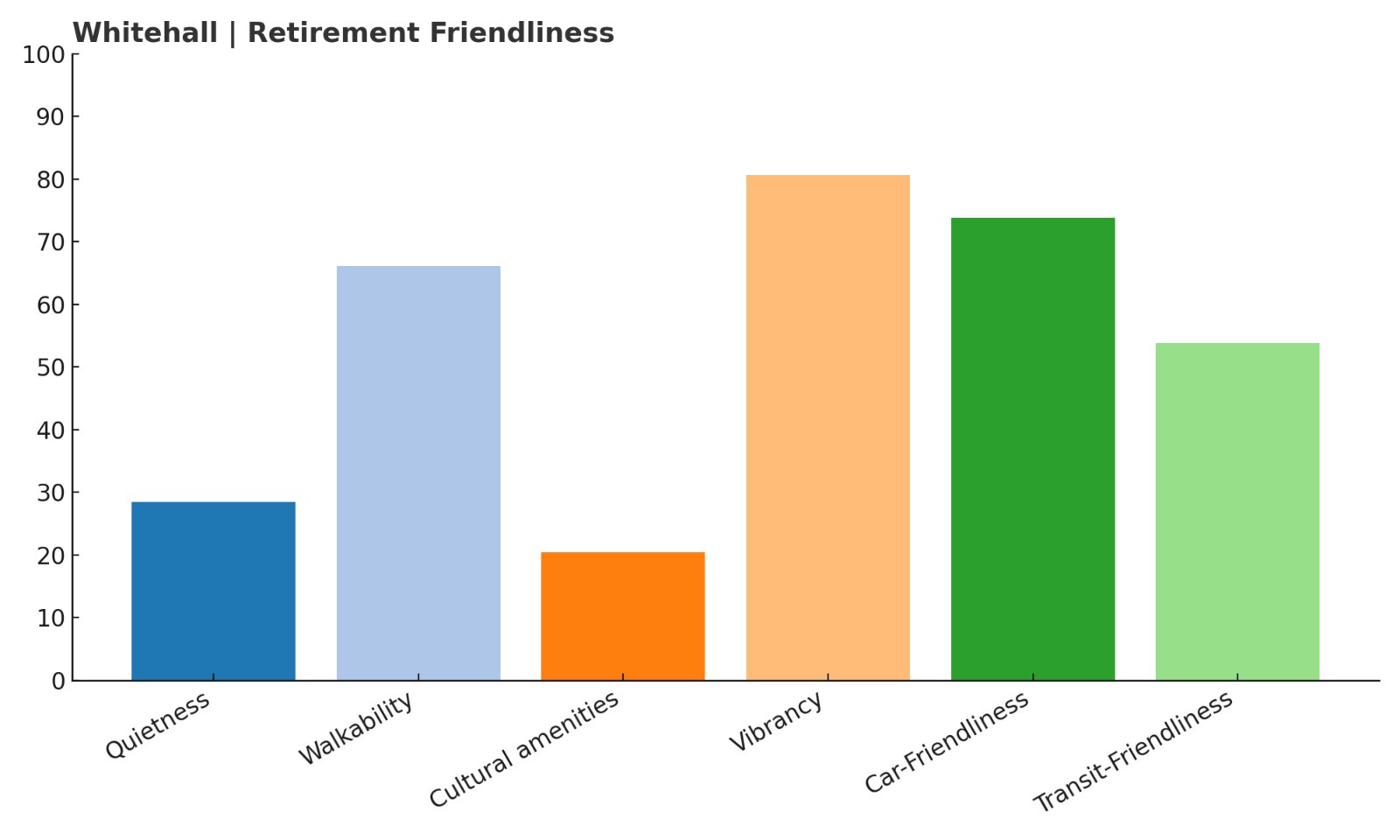
- Overall Retirement Score: 13.18
- Quietness: 28.42
- Walkability: 66.15
- Cultural amenities: 20.38
- Vibrancy: 80.6
- Car-Friendliness: 73.79
- Transit-Friendliness: 53.79
Whitehall’s low quietness (28.42) and limited senior-focused amenities make retirement life challenging. High vibrancy suggests constant activity, unsuitable for seniors looking for calmness and security.
1. Lincoln Heights – Ohio’s Least Senior-Friendly Town

Lincoln Heights, located north of Cincinnati, is consistently ranked as one of Ohio’s most challenging communities, particularly for retirees. Severe economic hardships have left the town with inadequate infrastructure, minimal healthcare options, and limited senior-specific services. Its reputation for safety issues and poor living conditions further discourages seniors from settling here.
Although affordable, Lincoln Heights offers little to support the active or peaceful retirement seniors desire. Younger adults or those seeking very low-cost housing might cope with the drawbacks, but retirees typically require more stable and supportive environments.
Lincoln Heights – ORS 3.63
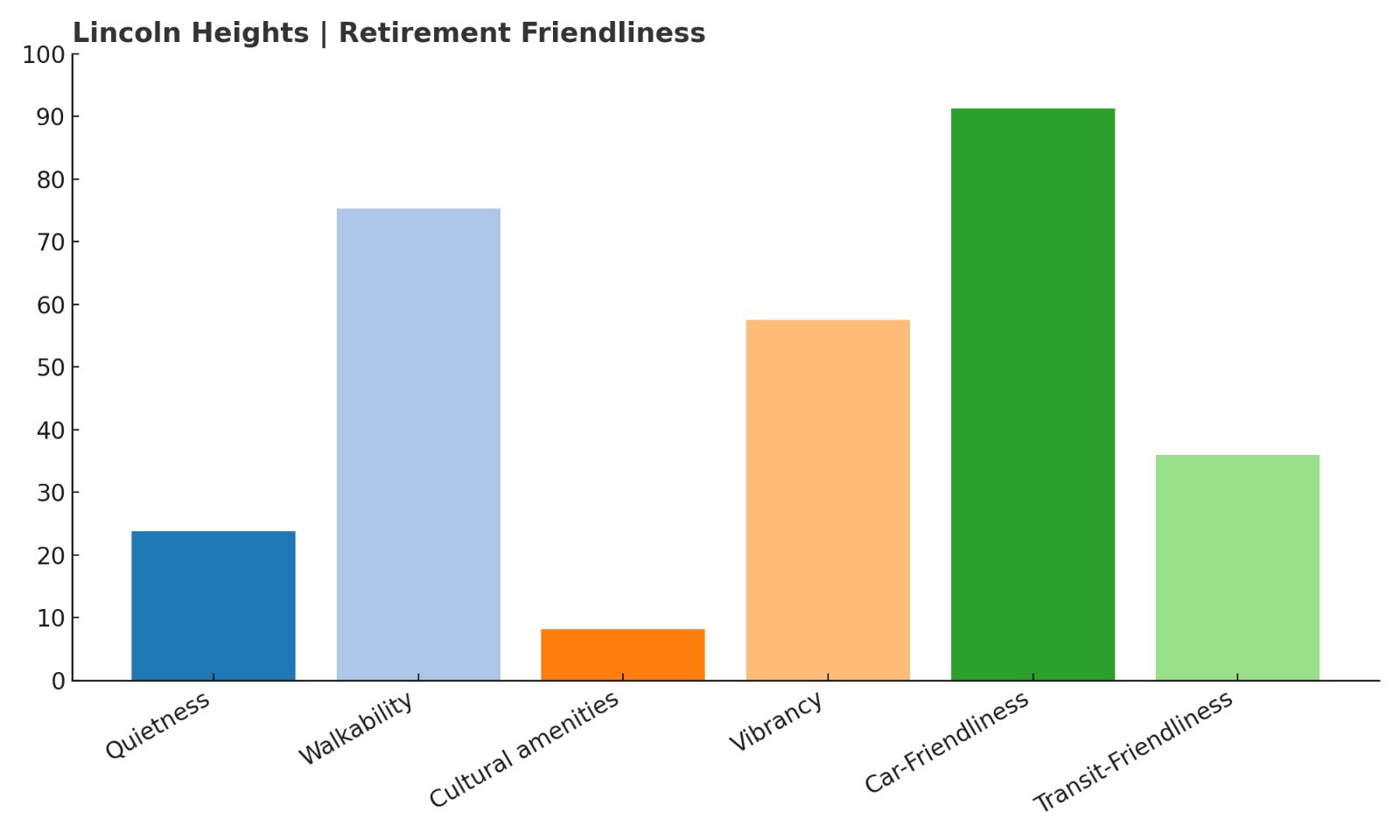
- Overall Retirement Score: 3.63
- Quietness: 23.73
- Walkability: 75.27
- Cultural amenities: 8.13
- Vibrancy: 57.55
- Car-Friendliness: 91.3
- Transit-Friendliness: 35.94
Lincoln Heights’ extremely low ORS (3.63) confirms its position as Ohio’s least retiree-friendly town. Poor cultural amenities, limited quietness, and subpar transit infrastructure make retirement living challenging and uncomfortable here.






